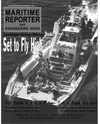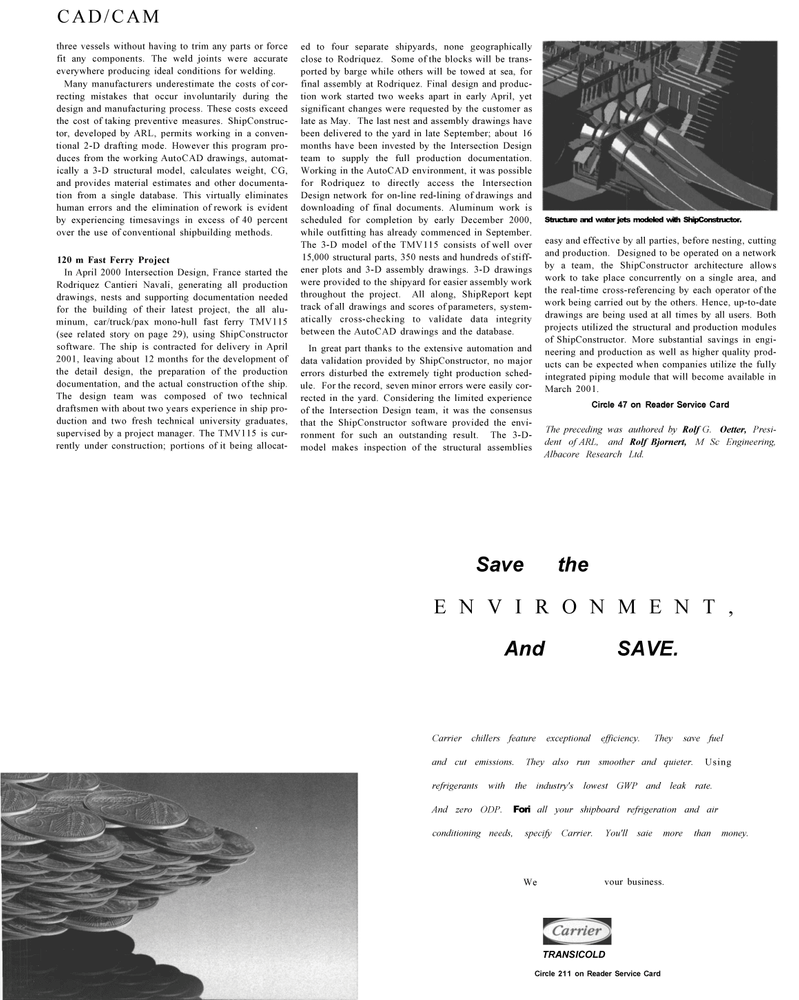
Page 37: of Maritime Reporter Magazine (January 2001)
Read this page in Pdf, Flash or Html5 edition of January 2001 Maritime Reporter Magazine
CAD/CAM three vessels without having to trim any parts or force fit any components. The weld joints were accurate everywhere producing ideal conditions for welding.
Many manufacturers underestimate the costs of cor- recting mistakes that occur involuntarily during the design and manufacturing process. These costs exceed the cost of taking preventive measures. ShipConstruc- tor, developed by ARL, permits working in a conven- tional 2-D drafting mode. However this program pro- duces from the working AutoCAD drawings, automat- ically a 3-D structural model, calculates weight, CG, and provides material estimates and other documenta- tion from a single database. This virtually eliminates human errors and the elimination of rework is evident by experiencing timesavings in excess of 40 percent over the use of conventional shipbuilding methods. 120 m Fast Ferry Project
In April 2000 Intersection Design, France started the
Rodriquez Cantieri Navali, generating all production drawings, nests and supporting documentation needed for the building of their latest project, the all alu- minum, car/truck/pax mono-hull fast ferry TMV115 (see related story on page 29), using ShipConstructor software. The ship is contracted for delivery in April 2001, leaving about 12 months for the development of the detail design, the preparation of the production documentation, and the actual construction of the ship.
The design team was composed of two technical draftsmen with about two years experience in ship pro- duction and two fresh technical university graduates, supervised by a project manager. The TMV115 is cur- rently under construction; portions of it being allocat- ed to four separate shipyards, none geographically close to Rodriquez. Some of the blocks will be trans- ported by barge while others will be towed at sea, for final assembly at Rodriquez. Final design and produc- tion work started two weeks apart in early April, yet significant changes were requested by the customer as late as May. The last nest and assembly drawings have been delivered to the yard in late September; about 16 months have been invested by the Intersection Design team to supply the full production documentation.
Working in the AutoCAD environment, it was possible for Rodriquez to directly access the Intersection
Design network for on-line red-lining of drawings and downloading of final documents. Aluminum work is scheduled for completion by early December 2000, while outfitting has already commenced in September.
The 3-D model of the TMV115 consists of well over 15,000 structural parts, 350 nests and hundreds of stiff- ener plots and 3-D assembly drawings. 3-D drawings were provided to the shipyard for easier assembly work throughout the project. All along, ShipReport kept track of all drawings and scores of parameters, system- atically cross-checking to validate data integrity between the AutoCAD drawings and the database.
In great part thanks to the extensive automation and data validation provided by ShipConstructor, no major errors disturbed the extremely tight production sched- ule. For the record, seven minor errors were easily cor- rected in the yard. Considering the limited experience of the Intersection Design team, it was the consensus that the ShipConstructor software provided the envi- ronment for such an outstanding result. The 3-D- model makes inspection of the structural assemblies
Structure and water jets modeled with ShipConstructor. easy and effective by all parties, before nesting, cutting and production. Designed to be operated on a network by a team, the ShipConstructor architecture allows work to take place concurrently on a single area, and the real-time cross-referencing by each operator of the work being carried out by the others. Hence, up-to-date drawings are being used at all times by all users. Both projects utilized the structural and production modules of ShipConstructor. More substantial savings in engi- neering and production as well as higher quality prod- ucts can be expected when companies utilize the fully integrated piping module that will become available in
March 2001.
Circle 47 on Reader Service Card
The preceding was authored by Rolf G. Oetter, Presi- dent of ARL, and Rolf Bjornert, M Sc Engineering,
Albacore Research Ltd.
Save the
ENVIRONMENT,
And SAVE.
Carrier chillers feature exceptional efficiency. They save fuel and cut emissions. They also run smoother and quieter. Using refrigerants with the industry's lowest GWP and leak rate.
And zero ODP. Fori all your shipboard refrigeration and air conditioning needs, specify Carrier. You'll saie more than money.
We vour business.
TRANSICOLD
Circle 211 on Reader Service Card

 36
36

 38
38
